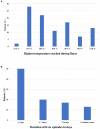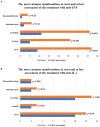Axial spondyloarthritis in patients with recurrent fever attacks: data from the AIDA network registry for undifferentiated autoInflammatory diseases (USAIDs)
- PMID: 37324154
- PMCID: PMC10263060
- DOI: 10.3389/fmed.2023.1195995
Axial spondyloarthritis in patients with recurrent fever attacks: data from the AIDA network registry for undifferentiated autoInflammatory diseases (USAIDs)
Abstract
Beckground: Despite the recent advances in the field of autoinflammatory diseases, most patients with recurrent fever episodes do not have any defined diagnosis. The present study aims at describing a cohort of patients suffering from apparently unexplained recurrent fever, in whom non-radiographic axial spondylarthritis (SpA) represented the unique diagnosis identified after a complete clinical and radiologic assessment.
Materials and methods: Patients' data were obtained from the international registry on Undifferentiated Systemic AutoInflammatory Diseases (USAIDs) developed by the AutoInflammatory Disease Alliance (AIDA) network.
Results: A total of 54 patients with recurrent fever episodes were also affected by non-radiographic axial SpA according to the international classification criteria. SpA was diagnosed after the start of fever episodes in all cases; the mean age at the diagnosis of axial SpA was 39.9 ± 14.8 years with a diagnostic delay of 9.3 years. The highest body temperature reached during flares was 42°C, with a mean temperature of 38.8 ± 1.1°C. The most frequent manifestations associated to fever were: arthralgia in 33 (61.1%) cases, myalgia in 24 (44.4%) cases, arthritis in 22 (40.7%) cases, headache in 15 (27.8%) cases, diarrhea in 14 (25.9%) cases, abdominal pain in 13 (24.1%) cases, and skin rash in 12 (22.1%) cases. Twenty-four (44.4%) patients have taken daily or on-demand non-steroidal anti-inflammatory drugs (NSAIDs) and 31 (57.4%) patients have been treated with daily or on demand oral glucocorticoids. Colchicine was used in 28 (51.8%) patients, while other conventional disease modifying anti-rheumatic drugs (cDMARDs) were employed in 28 (51.8%) patients. Forty (74.1%) patients underwent anti-tumor necrosis factor (TNF) agents and 11 (20.4%) were treated with interleukin (IL)-1 inhibitors. The response to TNF inhibitors on recurrent fever episodes appeared more effective than that observed with anti-IL-1 agents; colchicine and other cDMARDs were more useful when combined with biotechnological agents.
Conclusion: Signs and symptoms referring to axial SpA should be inquired in patients with apparently unexplained recurrent fever episodes. The specific treatment for axial SpA may lead to a remarkable improvement in the severity and/or frequency of fever episodes in patients with unexplained fevers and concomitant axial SpA.
Keywords: SpA; arthritis; autoinflammatory diseases; diagnosis; outcome; treatment.
Copyright © 2023 Vitale, Caggiano, Silva, Oliveira, Ruscitti, Ciccia, Vasi, Tufan, Lopalco, AlMaghlouth, Sota, Wiesik-Szewczyk, Gaggiano, Giardini, Spedicato, Ragab, Iannone, Balistreri, Frassi, Hernández-Rodríguez, Fabiani, Falsetti, Di Meglio, Frediani, Mazzei, Rigante, Faria and Cantarini.
Conflict of interest statement
The authors declare that the research was conducted in the absence of any commercial or financial relationships that could be construed as a potential conflict of interest.
Figures



References
-
- Muscari I, Iacoponi F, Cantarini L, Lucherini OM, Simonini G, Brizi MG, et al. . The diagnostic evaluation of patients with potential adult-onset autoinflammatory disorders: our experience and review of the literature. Autoimmun Rev. (2012) 12:10–3. doi: 10.1016/j.autrev.2012.07.015, PMID: - DOI - PubMed
LinkOut - more resources
Full Text Sources

